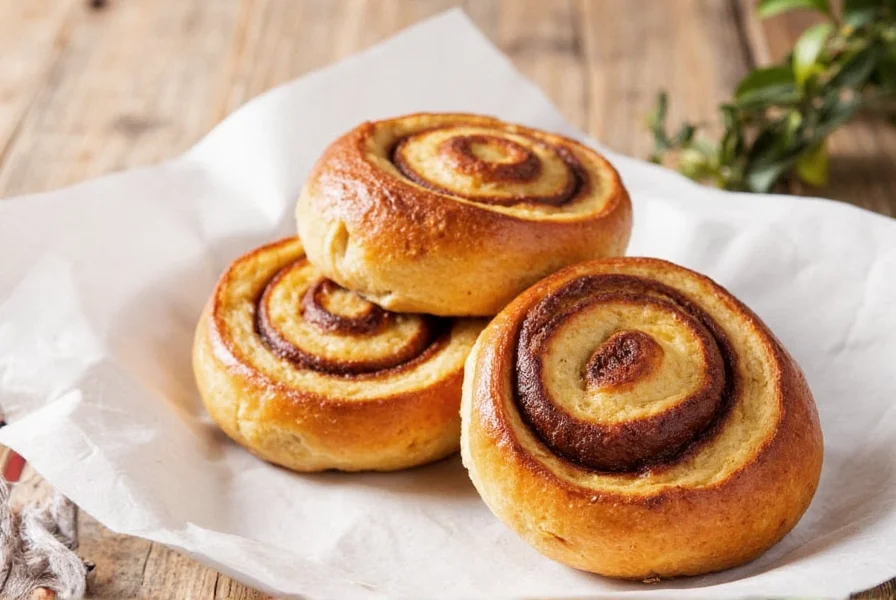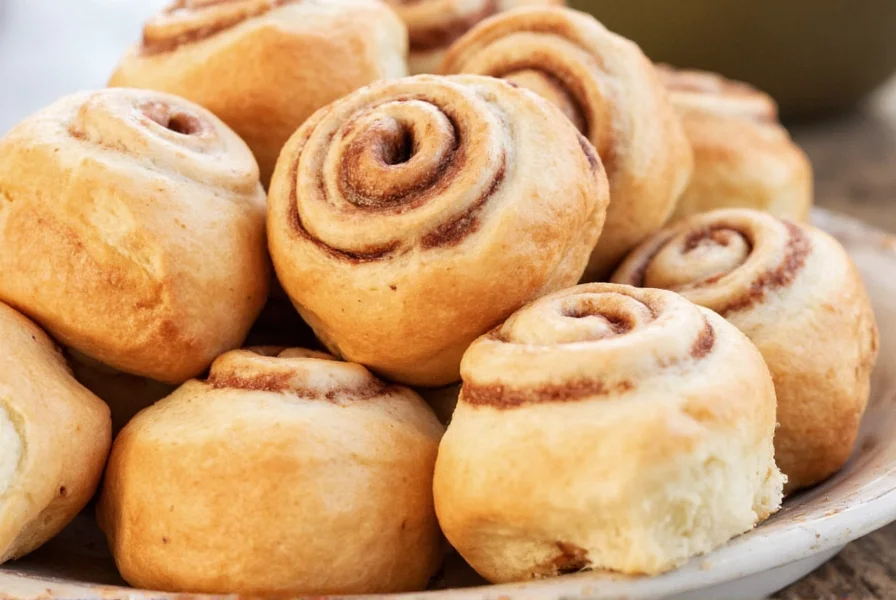Proper cinnamon roll storage preserves that perfect soft texture and rich flavor you love. Whether you've baked a large batch or have leftovers from your favorite bakery, understanding the right storage techniques prevents waste and ensures you enjoy them at their best. This guide covers all storage methods with specific timeframes and step-by-step instructions based on food safety standards.
Understanding Cinnamon Roll Storage Options
Cinnamon rolls contain perishable ingredients like dairy, eggs, and yeast that require proper handling. The sugar and moisture content makes them particularly vulnerable to drying out, mold growth, and texture changes when stored incorrectly. Your storage method should match your consumption timeline for optimal results.
Room Temperature Storage (Best for Same-Day Consumption)
Room temperature storage works well for cinnamon rolls you'll eat within 24 hours. This method maintains the ideal soft texture without requiring reheating.
| Storage Method | Duration | Best For |
|---|---|---|
| Airtight container with paper towel | Up to 24 hours | Freshly baked rolls eaten same day |
| Plastic wrap + container | 12-18 hours | Glossy bakery-style rolls |
| Freezer bag (squeezed air out) | 8-12 hours | Travel or short-term transport |
Step-by-Step Room Temperature Storage
- Cool completely: Allow rolls to cool on wire rack for 1-2 hours until completely room temperature
- Line container: Place paper towel at bottom of airtight container
- Single layer: Arrange rolls without touching to prevent sticking
- Add moisture barrier: Place another paper towel on top of rolls
- Seal tightly: Close container with secure lid
- Store in cool place: Keep away from direct sunlight or heat sources
Refrigerator Storage (3-5 Days)
Refrigeration extends freshness when you need to keep cinnamon rolls beyond one day. The cold environment slows mold growth but can accelerate staling, so proper wrapping is essential.
Proper Refrigeration Technique
For best results when refrigerating cinnamon rolls, follow these steps:
- Wrap each roll individually in plastic wrap, pressing out air pockets
- Place wrapped rolls in a single layer inside a freezer-safe container
- Add a small piece of bread to the container (absorbs excess moisture)
- Seal container tightly before placing in refrigerator
- Store on middle shelf (most consistent temperature)
When stored properly, refrigerated cinnamon rolls maintain quality for 3-5 days. The cream cheese frosting may soften slightly but will firm up again when reheated.
Freezing Cinnamon Rolls (2-3 Months)
Freezing provides the longest storage option while preserving quality. Both baked and unbaked cinnamon rolls freeze well with proper preparation.
Freezing Baked Cinnamon Rolls
- Cool completely: Ensure rolls reach room temperature
- Flash freeze: Place on parchment-lined baking sheet for 1 hour
- Double wrap: First in plastic wrap, then in aluminum foil
- Vacuum seal (optional): For longest storage, use vacuum sealer
- Label: Include date and contents on packaging
- Store in freezer: Place in back where temperature is most consistent
Freezing Unbaked Cinnamon Rolls
Unbaked cinnamon rolls freeze exceptionally well, allowing you to bake fresh rolls whenever desired. This method preserves the best texture and flavor.
- Prepare as usual: Complete all steps through rolling and cutting
- Flash freeze: Place rolls on parchment-lined baking sheet for 2 hours
- Transfer to container: Move frozen rolls to airtight freezer container
- Store flat: Keep container horizontal to prevent deformation
- Label clearly: Note "unbaked" and date
When stored properly, unbaked cinnamon rolls maintain quality for 2-3 months in the freezer. You can bake them straight from frozen with slightly adjusted baking time.

Reheating Stored Cinnamon Rolls
The reheating method significantly impacts the final texture and quality of stored cinnamon rolls. Match your reheating technique to the storage method used.
| Storage Method | Reheating Method | Time | Result |
|---|---|---|---|
| Room temperature | 30-second microwave | 30 sec | Warm, soft center |
| Refrigerated | Oven at 300°F | 8-10 min | Evenly warmed, no soggy spots |
| Frozen (baked) | Oven at 325°F | 15-20 min | Fresh-baked texture |
| Frozen (unbaked) | Oven at 350°F | 25-30 min | Perfectly risen, fresh-baked |
Signs Cinnamon Rolls Have Gone Bad
Knowing when to discard stored cinnamon rolls prevents foodborne illness. Check for these indicators before consuming:
- Mold growth: Any visible fuzzy spots (white, green, or black)
- Off smell: Sour or fermented odor instead of sweet cinnamon
- Texture changes: Excessive hardness or slimy surface
- Discoloration: Dark spots or uneven coloration
- Frosting separation: Liquid pooling under cream cheese frosting
When in doubt, throw it out. Consuming spoiled cinnamon rolls can cause food poisoning with symptoms including nausea, vomiting, and diarrhea.
Expert Tips for Maximum Freshness
Professional bakers use these techniques to extend cinnamon roll shelf life:
- Add a slice of apple to room temperature storage containers (releases moisture)
- Store frosting separately when possible for best texture
- Use glass containers instead of plastic for refrigerator storage (less odor absorption)
- Place a damp paper towel in container when reheating in microwave
- Never store near strong-smelling foods (cinnamon rolls absorb odors easily)

Common Questions About Cinnamon Roll Storage
Can you store cinnamon rolls without refrigeration?
Yes, freshly baked cinnamon rolls can be stored at room temperature for up to 24 hours in an airtight container. Place paper towels above and below the rolls to absorb excess moisture while maintaining softness. For longer storage beyond one day, refrigeration or freezing is necessary to prevent spoilage.
How do you keep cinnamon rolls from getting hard?
To prevent hardening, always wrap cinnamon rolls tightly in plastic wrap before placing in airtight containers. The double barrier prevents moisture loss. When storing multiple rolls, place parchment paper between layers. For room temperature storage, include a small piece of bread in the container which will dry out instead of your cinnamon rolls.
Can you freeze cinnamon rolls with icing?
Yes, but for best results, freeze cinnamon rolls without icing and add frosting after reheating. If already iced, flash freeze uncovered for 1 hour before wrapping to prevent the icing from sticking to packaging. Cream cheese frosting may separate slightly when frozen and thawed, but regains consistency after gentle reheating.
How long do homemade cinnamon rolls last in the fridge?
Properly stored homemade cinnamon rolls maintain quality in the refrigerator for 3-5 days. Wrap each roll individually in plastic wrap, then place in an airtight container with a paper towel to absorb excess moisture. Rolls with cream cheese frosting may last slightly less time (2-3 days) due to the dairy content.
What's the best way to reheat frozen cinnamon rolls?
The best method for reheating frozen cinnamon rolls is in the oven at 325°F for 15-20 minutes. Thawing at room temperature for 30 minutes before reheating yields the most even results. For quick reheating, microwave at 50% power for 45-60 seconds with a damp paper towel covering the roll to prevent drying.










 浙公网安备
33010002000092号
浙公网安备
33010002000092号 浙B2-20120091-4
浙B2-20120091-4